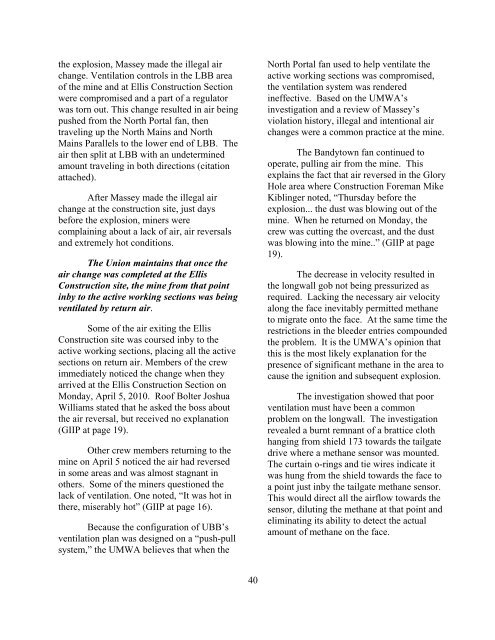Industrial Homicide - United Mine Workers of America
Industrial Homicide - United Mine Workers of America
Industrial Homicide - United Mine Workers of America
You also want an ePaper? Increase the reach of your titles
YUMPU automatically turns print PDFs into web optimized ePapers that Google loves.
the explosion, Massey made the illegal air<br />
change. Ventilation controls in the LBB area<br />
<strong>of</strong> the mine and at Ellis Construction Section<br />
were compromised and a part <strong>of</strong> a regulator<br />
was torn out. This change resulted in air being<br />
pushed from the North Portal fan, then<br />
traveling up the North Mains and North<br />
Mains Parallels to the lower end <strong>of</strong> LBB. The<br />
air then split at LBB with an undetermined<br />
amount traveling in both directions (citation<br />
attached).<br />
After Massey made the illegal air<br />
change at the construction site, just days<br />
before the explosion, miners were<br />
complaining about a lack <strong>of</strong> air, air reversals<br />
and extremely hot conditions.<br />
The Union maintains that once the<br />
air change was completed at the Ellis<br />
Construction site, the mine from that point<br />
inby to the active working sections was being<br />
ventilated by return air.<br />
Some <strong>of</strong> the air exiting the Ellis<br />
Construction site was coursed inby to the<br />
active working sections, placing all the active<br />
sections on return air. Members <strong>of</strong> the crew<br />
immediately noticed the change when they<br />
arrived at the Ellis Construction Section on<br />
Monday, April 5, 2010. Ro<strong>of</strong> Bolter Joshua<br />
Williams stated that he asked the boss about<br />
the air reversal, but received no explanation<br />
(GIIP at page 19).<br />
Other crew members returning to the<br />
mine on April 5 noticed the air had reversed<br />
in some areas and was almost stagnant in<br />
others. Some <strong>of</strong> the miners questioned the<br />
lack <strong>of</strong> ventilation. One noted, “It was hot in<br />
there, miserably hot” (GIIP at page 16).<br />
Because the configuration <strong>of</strong> UBB’s<br />
ventilation plan was designed on a “push-pull<br />
system,” the UMWA believes that when the<br />
North Portal fan used to help ventilate the<br />
active working sections was compromised,<br />
the ventilation system was rendered<br />
ineffective. Based on the UMWA’s<br />
investigation and a review <strong>of</strong> Massey’s<br />
violation history, illegal and intentional air<br />
changes were a common practice at the mine.<br />
The Bandytown fan continued to<br />
operate, pulling air from the mine. This<br />
explains the fact that air reversed in the Glory<br />
Hole area where Construction Foreman Mike<br />
Kiblinger noted, “Thursday before the<br />
explosion... the dust was blowing out <strong>of</strong> the<br />
mine. When he returned on Monday, the<br />
crew was cutting the overcast, and the dust<br />
was blowing into the mine..” (GIIP at page<br />
19).<br />
The decrease in velocity resulted in<br />
the longwall gob not being pressurized as<br />
required. Lacking the necessary air velocity<br />
along the face inevitably permitted methane<br />
to migrate onto the face. At the same time the<br />
restrictions in the bleeder entries compounded<br />
the problem. It is the UMWA’s opinion that<br />
this is the most likely explanation for the<br />
presence <strong>of</strong> significant methane in the area to<br />
cause the ignition and subsequent explosion.<br />
The investigation showed that poor<br />
ventilation must have been a common<br />
problem on the longwall. The investigation<br />
revealed a burnt remnant <strong>of</strong> a brattice cloth<br />
hanging from shield 173 towards the tailgate<br />
drive where a methane sensor was mounted.<br />
The curtain o-rings and tie wires indicate it<br />
was hung from the shield towards the face to<br />
a point just inby the tailgate methane sensor.<br />
This would direct all the airflow towards the<br />
sensor, diluting the methane at that point and<br />
eliminating its ability to detect the actual<br />
amount <strong>of</strong> methane on the face.<br />
40
















